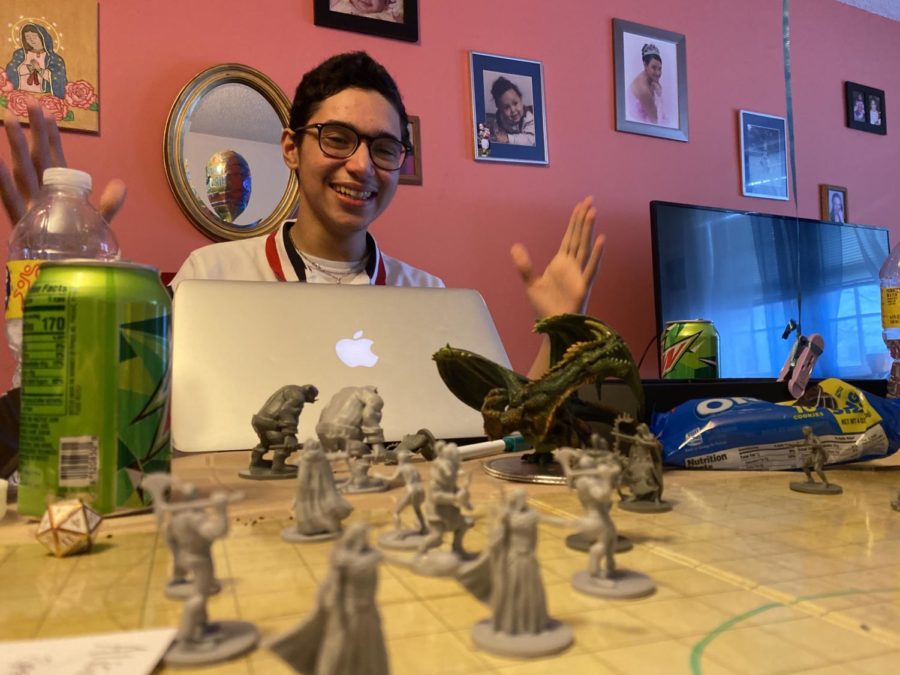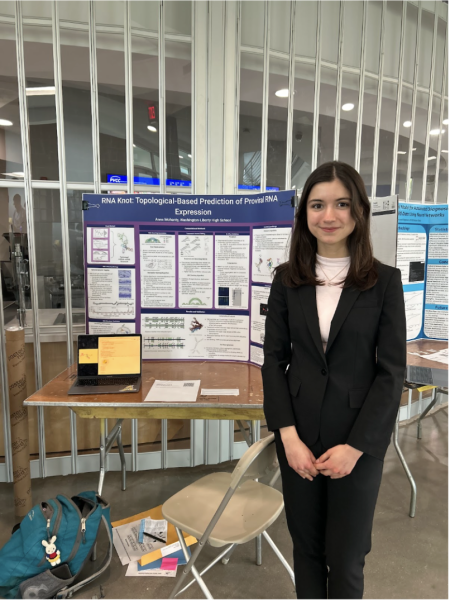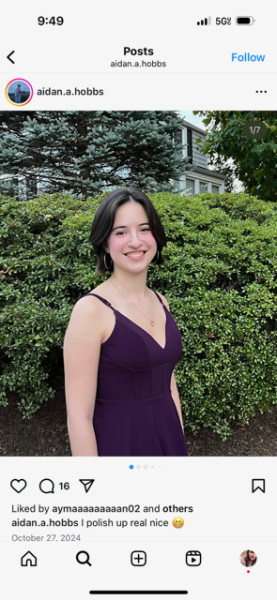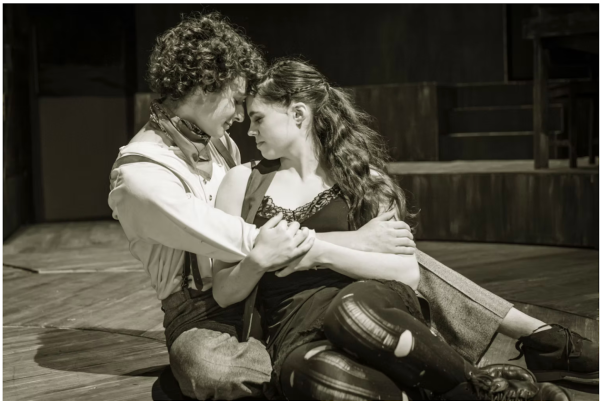Dungeons, dragons, and much more
How and why D&D captures the attentions of teens around the world
Senior Ludwin Moreno acts as Dungeon Master, in charge of the fight scene in front of him
Several teens crowd around a large table covered in snacks, drinks, action figures, colorful dice and a large plastic board with a grid printed on it. An elaborate battle scene decorates the board, with each teen’s figurine surrounding a large monster in the center. Dramatic music plays in the background as everyone focuses on the leader of the group, who is about to roll a 20-sided die. The die rolls across the board and lands on a five. All of the players sigh in relief, having dodged a deadly blow from the monster in the center of the table.
This is just an example of one of the many Dungeons and Dragons Campaigns that students run both within and outside of the school.
“D&D is a tabletop roleplaying game,” senior Ludwin Moreno said. “It’s sort of like, if you mixed the childhood imagination with actual concrete dice and math. “
The game consists mostly of talking, as the players explore a made up world created for them by the leader of the group, the Dungeon Master. Usually referred to as the DM, their job is to create a thrilling adventure for the players, including creating the monsters, side characters, locations, environment and plot. The DM is like an old story teller at the edge of a campfire, except this story is interactive.
“I would say [D&D] is a game in which the Dungeon Master holds all of the characters and secrets of the world,” sophomore Sophia Braier said. “Everybody else plays as the characters who get to explore it.”
There is no real prize at the end of the game unless the DM creates one or the players decide to pursue one. Instead, the overall goal of the campaign is just to goof off and have fun. The freedom to create your own world, story and rules is what makes D&D such a unique and personal experience, no matter how many times you play.
“Typically, it’s fantasy,” Moreno said. “Sometimes people spin it to be Sci-Fi or steampunk, and all that stuff. But typically it’s fantasy.”
The company does have pre-made worlds and stories as well, with new ones coming up with each new edition of the rules. Although the name of the game is called Dungeons and Dragons, neither dungeons or dragons are necessary for a thrilling adventure.
“I do recall the company itself wanting to change the name to Dungeons and/or Dragons, which I think is not a good idea,” Moreno said. “In Dungeons and Dragons, you don’t need to have dungeons or dragons in your game. It was just a name.”
While the DM is able to create the surroundings and plot of the adventure, the course of the campaign is ultimately decided by the players as they choose where to explore and who to interact with.
“The ability to change the rule creates this feeling of personalization amongst the group,” senior Stephen Zayd Kouar said. “If you want something to be a certain way, you can literally just talk to your Game Master.”
The players are not all-powerful, though; for some actions you need to roll a dice to determine how successful you are.
“A [check] requires you to roll a dice to determine how successful you are at doing that action,” Kouar said. “These are called checks. For checks, you roll something called a D20, which is a dice with 20 sides all numbered one through 20.”
A D20 is one of the most commonly-used dice in the game. If you roll a high number, you perform an action, attack, persuasion, deception, etc, extremely well depending on how high you roll. If you roll low, you fail that action and have to face the consequences. If you roll a 1 on anything, the DM gets to decide your fate, as long as it’s negative. This usually ends with the DM awarding the player’s character with some form of damage. On the other end of the spectrum, if you roll a Natural 20 (Nat20) then you get to choose your own fate.
“You do essentially quick math, add [the numbers you rolled] all together, and find out how that action played out,” Kouar said, “Whether you were successful in talking your way into a lower price at a bazaar or if you absolutely failed at entertaining the king.”
The players can decide how to react to challenges based on their own will, or the backstories and personalities they have decided for their characters.
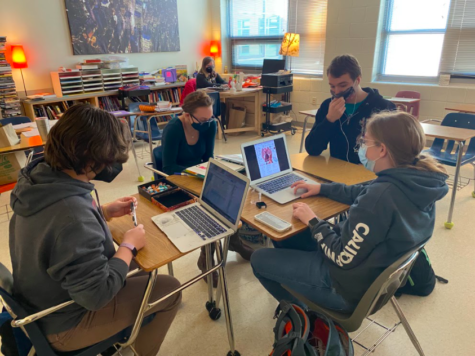
(Kayla Combs)
“Oftentimes in D&D you will be faced with a choice, and you can do whatever you wish to, or whatever you think would be what your character’s motives would be,” Kouar said. “You can act however you want to act, or as whoever you want. It’s totally up to you and the DM.”
When creating a character, the player picks a race, such as a Dwarf, Elf, Halfling, Human, Dragonborn, Gnome, Half-elf, Half-orc, Tiefling, or something completely made up. Each race has special attributes that can be added to the character’s backstory. A character’s class is basically what type of team member they want to be, and what type of magic you may want to use. Some of the ready-made classes are: Barbarian, Bard, Cleric, Druid, Fighter, Monk, Paladin, Ranger, Rogue, Sorcerer, Warlock and Wizard.
Your character gets positive and negative “bonuses” that are added to checks to help you decide the outcome of an action. Bonuses apply to strength, dexterity, constitution, intelligence, wisdom and charisma. They normally are defining character traits and determine how you will help the team. The DM needs to accommodate all of these in their challenges for the characters.
“The first couple of sessions, my notes were like pages long,” senior Jeremy Meehan said. “Then by the end of [the campaign], I had maybe like two sentences of notes and I improvised the rest of it. [The sessions] got way less stressful afterwards, which is confusing because [the adventure] just went more and more off the rails as we went on.”
D&D’s popularity has grown and declined over the years since its original release in 1974, with several different editions of the rules being released and edition 5.5e coming out soon. Today, more people have heard about the game through media and friends than ever before.
“I definitely know it’s [popularity has] been caused by how simple the fifth edition is,” Moreno said. “Also the growth of popularity of podcasts like Critical Role, Dimension 20, and stuff like that.”
Movies and TV shows such as “Stranger Things” have also boosted the game’s popularity, although some people were concerned about the show’s representation of the game.
“I feel like it’s a disingenuous growth in popularity, because what they saw was the first edition of D&D,” Moreno said. “So then when they go to play D&D, they’re gonna be like, ‘this is nothing at all like “Stranger Things”!’ … Just saying, the Demogorgon in D&D is not the same in “Stranger Things.” “Stranger Things”, I feel, did help a bit in popularity, but it didn’t do it really correctly.”
This year at the school, the Tabletop Games Club was formed to play Magic the Gathering, Bloodborne, and Dungeons and Dragons. A similar club had existed in the school before quarantine called The Advanced Strategies Club, but it had ended meetings during virtual learning. Senior Henry Abyad decided to revive the club with the new name, The Tabletop Games Club, which quickly grew more popular.
“I recall the first day where we said, ‘we’re going to start character creation for D&D, So if you want to join a campaign, come now,’” Moreno said. “I go to the club. I’m waiting for people to come in, first It’s like six and I’m like ‘all right, I can take six,’ And then seven more come in for D&D and I’m like, ‘holy [cow]! I’m the only Dungeon Master. I can’t have 13 players!’”
Traditionally a campaign has only 3 to 6 players at one time, otherwise it’s much harder for the DM to plan battles and keep track of all the players.
“Luckily someone else who wanted to play D&D was like, ‘you know, I could be a dungeon master,’” Moreno said. “I was like, ‘Thank you! Thank you for that!’ So now we have two separate campaigns. Mine is Watergate Dragon Heist, the other one I believe is called a Horde of the Dragon Queen. So they’re both dragon related.”
Braier is the DM of the Horde of the Dragon Queen Campaign, which has been going on for three months now. The goal of the campaign was to defeat the infamous “Cult of the Dragon” and save the world from a fiery fate by infiltrating the cult and selling several different dragon eggs.
The other campaign in the club is run by Moreno, who has been playing D&D since middle school. His campaign, Waterdeep Dragon Heist, revolves around a large-scale heist that the players are planning. The story revolves around an overlord who stole and embezzled a ton of gold that is guarded by a dragon the players are attempting to find and defeat. The campaign is inspired by a pre-made world design book that the D&D company released called Waterdeep. Although the world is already built, Moreno creates all the characters and plots himself. Each session is jam packed with action, suspense, and laughs as the players immerse themselves in the story.
“I always love when I get to do a cliffhanger,” Moreno said. “Those are especially memorable because it gets the players thinking, and I love their reaction when they’re like, ‘What?” Then I just say, ‘And that’s when the session is over!’ and they’re like, ‘No!’ I don’t know why, that’s just so satisfying to hear. [I think] Because it fills me with this confidence that they’re really invested in this, and that makes me feel good, knowing that they’re invested in my story.”
There are plenty of students in the school who play D&D but are not in a club. Meehan, for example, just ended a campaign that had gone on for about six months. In the beginning, the story centered around piecing together a mysterious broken sword hilt, but it quickly spiraled out of control.
“They had been hired to figure this all out by a guy who was incredibly suspicious, but my players are like, ‘Eh, he’s fine,’” Meehan said. “So [the players] went back and they were like, ‘Hey, we found this,’ and then the guy was like, ‘great! I’m gonna use it for evil now.’ I was like, ‘who could have seen that coming.’… he was definitely evil.”
The suspicious man was supposed to be the “final boss” to end the adventure, but things didn’t exactly go as planned.
“That’s where I expected, honestly, the campaign to end,” Meehan said. “I was like, ‘it’s gonna be a short thing. We’re just gonna have a battle and they’re gonna get this sword back or whatever.’ Then my player that had the sword rolled a Nat20 on attack, which means that in that case, the sword did like a ton of damage, and my guy died.”
Meehan had to improvise after that to extend the campaign. One of the players was a Paladin, meaning they have a god of their choice that they worship and get granted power from. This character’s god happened to be Odin from Asgard, so that’s who the party decided to fight next.
“So in the fight against Odin, most everybody else except one player was unconscious and rolling death saves.” Meehan said. “My player got a Nat20, and they had the sword, so they did 112 damage to Odin at one time because they rolled a Nat20 and then maxed out the damage rolls. It was insane! The most epic moment.”
It is very difficult for DMs to combat Nat20s, it basically sends the player into a god-like state for a short period of time. Frustrated, Meehan decided to send the party to the underworld.
“In the second ring [of the underworld], I put a boss there that I intended for none of them to live through,” Meehan said. “I wanted to kill all of them. Not for a T.P.K. – a Total Party Kill, but I want to send them to the third ring of hell, which you could get to by dying, because you’re in the underworld. I completely butchered that mechanic but it was my campaign so I didn’t care.”
Eventually all of the players were killed and reached the third ring of the underworld, only to be sent back to Asgard again.
“Eventually I got them down there and then they got mailed in the U.P.P.S.R.B.D. [which is] the Universal Planet Postal Service Run By Demons,” Meehan said. “They got sent to Olympus because they were ordered by the gods, the ones who are still on their side. Then that’s where the final showdown with Thor arrived.”
Thor was the true final boss, ending the campaign after six months goofing around and fighting the gods. On the another perspective of a Nat20, player Kouar recalls the time he got extremely lucky on his rolls.
“One of my favorite moments was just a combat sequence where my character got ambushed by boars and I just started rolling so high that we eventually took my dice and weighed them because I kept on rolling Nat20s,” Kouar said. “We’ve rolled them and weighed them and I just became lucky. It was just luck. It was incredible, and honestly that sticks out as one of my favorite moments.”
Throughout the sessions, sometimes the players get so immersed in the story and role playing that they build an emotional connection to the game.
“My favorite thing about D&D campaigns is when I can get players to roleplay their backstories so well, that they actually go through character development,” Braier said. “I would want a campaign where it’s so character focused that like, people cry, that’s what I want. I want to make my players cry.”
Kouar actively tries to help the DM build the world up so much that it reaches that level, though asking questions and interacting with as many side characters as possible.
“I tried to make my characters believable and breathing parts of the world,” Kouar said. “I always wanted to help the DM create more about the world from me. I wanted to ask certain questions to find out more about the world. That’s what I did as a player. I was very inquisitive and most likely very annoying, because then the DM had to make up certain parts on the fly.”
Backstories are just as important as the character in the present, because it’s something the player creates for themselves, from themselves. It’s the closest connection the players have to their characters, and what adds emotional depth to each campaign.
“I try to incorporate their backstory into a part of the game,” Moreno said. “For example, one of the players, their backstory is that they left their family to be a pirate for 20 years. They’ve been searching for their family ever since they stopped being a pirate. Recently they just found their family and they’re having this whole arc of adjusting back to having a family again and also learning of everything that happened over the 20 years they’ve been gone.”
D&D creates an environment where people can be whoever they want and don’t have to fear being judged because it’s all part of a game.
“It’s positively affected my mental health.” Moreno said. “I didn’t really have an outlet to let out imagination. When I learned of D&D, I was like, ‘that’s cool. We can play it.’ The first time I played it, it was kind of lame. Then the second time I played it, when I took a shot at being a Dungeon Master, that’s when I was like, ‘wow! this D&D thing is cool!’ It’s given me a new hobby, because before it was just video games or lying down watching YouTube. Now with D&D I can read their books and plan and design stuff, which is so cool.”
Personal connections and friendships with your teammates is what the game is all about. Through D&D some people are able to make friendships they never would have had otherwise.
“I don’t think that I saw a lot of these people in school at all but it’s created life-lasting connections.” Kouar said. “I feel more connected with those four gents than I do a lot of other people, and I feel like they know a lot more about me than almost anyone else.”
D&D brings people together and creates memorable experiences that will stick with the players long after the campaigns are over.
“It’s a hobby that is very near and dear to my heart … D&D can be literally anything, and oftentimes, it’s not even what you think,” Kouar said. “Getting together for D&D often leads to next to no D&D being played, and it’s totally fine when that happens, because you’re not there for D&D. You’re not there to sit down and do competitive math with your buddies. You’re there to be with your buddies, and make jokes and just have a good time and tell the story. To me, D&D will always be a social activity, where people gather around tables, roll dice, and tell a story.”
What did you think about this story? Do you have any suggestions for improvements or other articles that you would like to see? Please use the contact form to communicate with us! (Keep all information school-appropriate)
https://docs.google.com/forms/d/e/1FAIpQLSeRYRWwLLzvs2rqwHSGdr-DQRvxhUSx9UcaXypXxnvVuCqwyA/viewform


